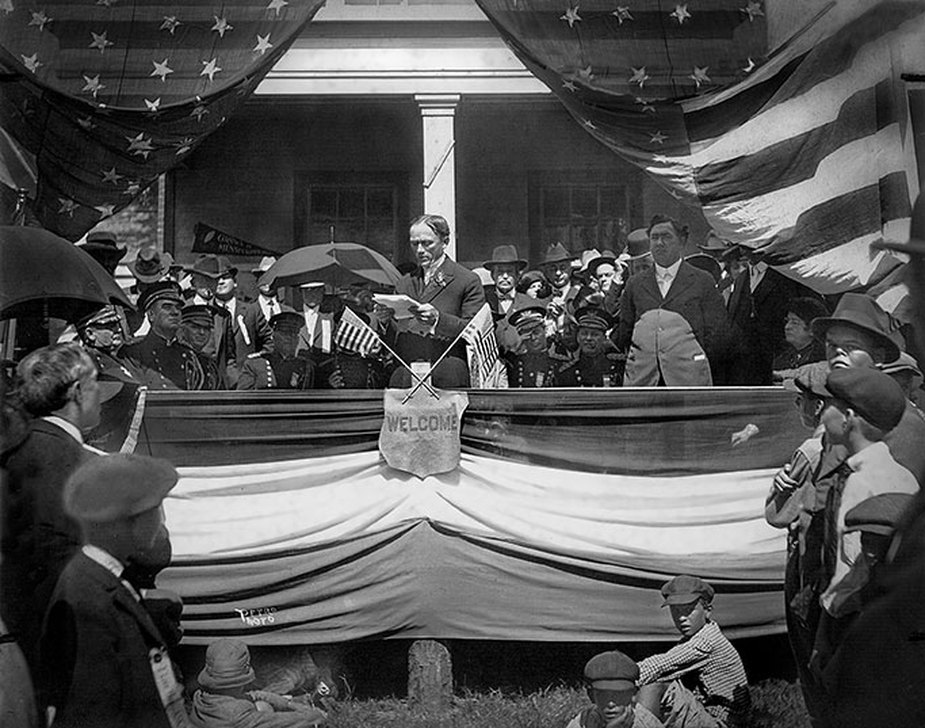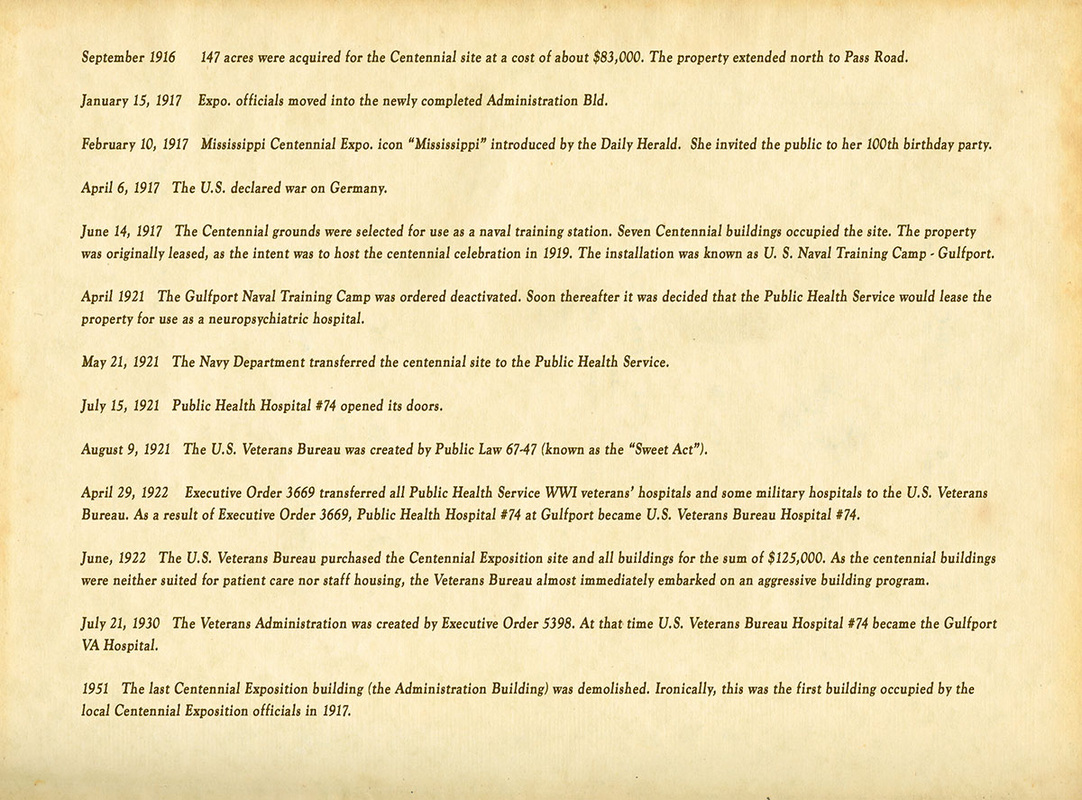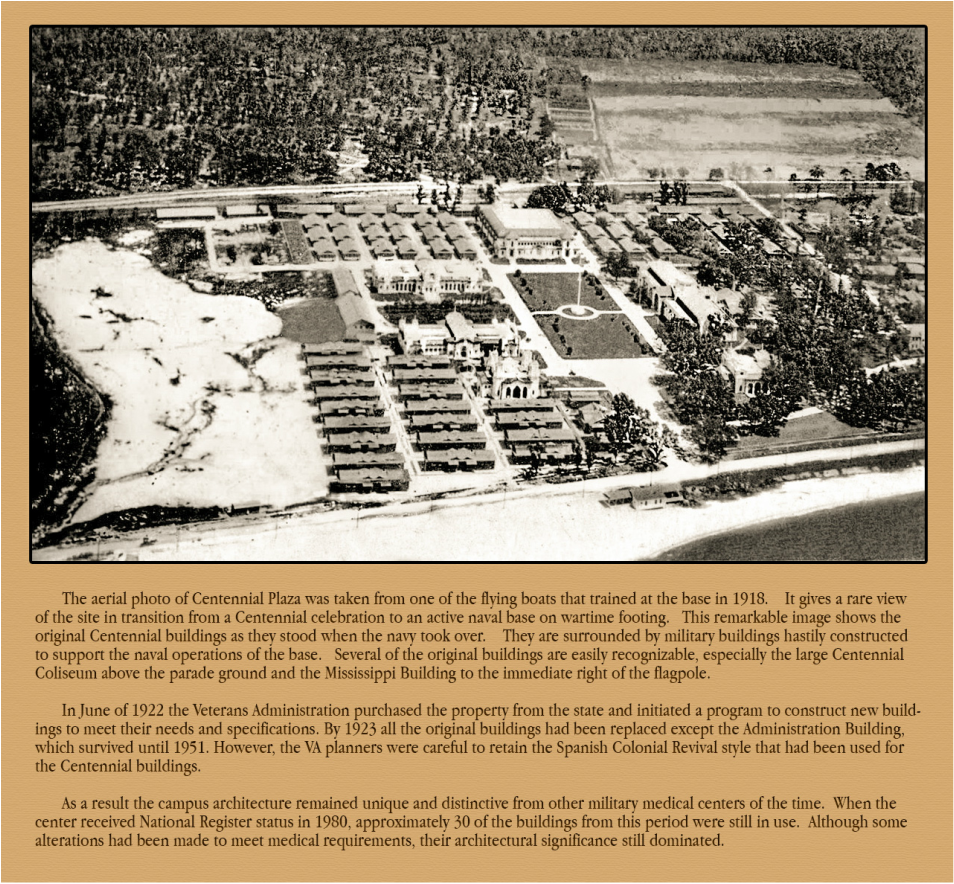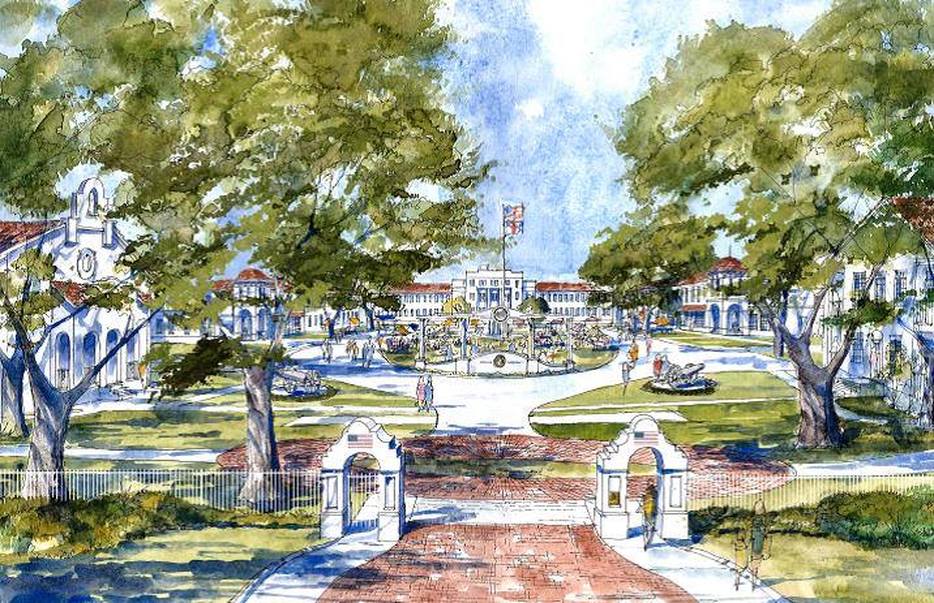The Mississippi Centennial story
The Mississippi Centennial: site selection
The F. S. Hewes home is pictured above on October 13, 1916, with Governor Theodore Bilbo speaking from the front porch at the groundbreaking ceremony.
A crowd of over 5,000 turned out for the event that was to have been the site for the centennial celebration of Mississippi entering the Union in 1817. As soon as Bilbo finished the speech, workmen tore down the old F.S. Hewes house to clear the way for the construction of a new administration building for the 1917 Centennial.
A crowd of over 5,000 turned out for the event that was to have been the site for the centennial celebration of Mississippi entering the Union in 1817. As soon as Bilbo finished the speech, workmen tore down the old F.S. Hewes house to clear the way for the construction of a new administration building for the 1917 Centennial.

The Mississippi Centennial:
early reference to the site
Mrs. Thomas Prentiss Gary, many years after the event, wrote an account of her family making a visit by train in 1896 to the new town of Gulfport. She recalled taking an extended trip down the beach shell road in a wagon pulled by Charley the mule. “…going east, the Seal’s place was the first home, then the Hewes’ homestead at Mississippi City where the Veterans Hospital stands today...”
The home Mrs. Gary and her two daughters described was owned by F. S. Hewes, Harrison County chancery clerk, where he and his wife raised 18 children. One son, Finley B. Hewes, was appointed Gulfport’s first mayor but was unable to take office as he was actively serving in Cuba during the Spanish American war.
early reference to the site
Mrs. Thomas Prentiss Gary, many years after the event, wrote an account of her family making a visit by train in 1896 to the new town of Gulfport. She recalled taking an extended trip down the beach shell road in a wagon pulled by Charley the mule. “…going east, the Seal’s place was the first home, then the Hewes’ homestead at Mississippi City where the Veterans Hospital stands today...”
The home Mrs. Gary and her two daughters described was owned by F. S. Hewes, Harrison County chancery clerk, where he and his wife raised 18 children. One son, Finley B. Hewes, was appointed Gulfport’s first mayor but was unable to take office as he was actively serving in Cuba during the Spanish American war.

The Mississippi Centennial: planning and promotion
The 92 acres, offering a beachfront view from the shade of hundreds of beautiful Live Oaks, were thought to be the ideal site to celebrate Mississippi’s 100th birthday in 1917. The Mississippi Centennial Exposition was established by the legislature and launched an exciting promotional campaign throughout the state and country, using all the media then available. This included Newspaper ads and articles and brochures. Mailings by merchants were imprinted with the exposition’s logo and message to show their supported the event and Centennial buttons were proudly worn.
The Mississippi Centennial: cancellation
Thousands of colorful postcards were sent out with pictures of the different exhibition halls and carrying the date Dec. 10, 1917 to June 10, 1918. With the advent of World War I, it was hoped that the Centennial could be simply delayed.
The same postcards were sent back to the printers to have the original dates blacked out and imprinted with a new date, “Open Feb 22, 1919.”
The Mississippi Centennial: in transition
As the scope of the global conflict consumed the nation and the Spanish flu pandemic racked the country, the Mississippi’s Centennial celebration receded into history. The site was given over to the war effort for military training and later become the Veterans Administration Medical Center – Gulfport Division. Once again postcard makers shifted designs and produced new cards promoting the Gulfport VA, often using images of the buildings intended for the Centennial.
Time line for the Centennial site
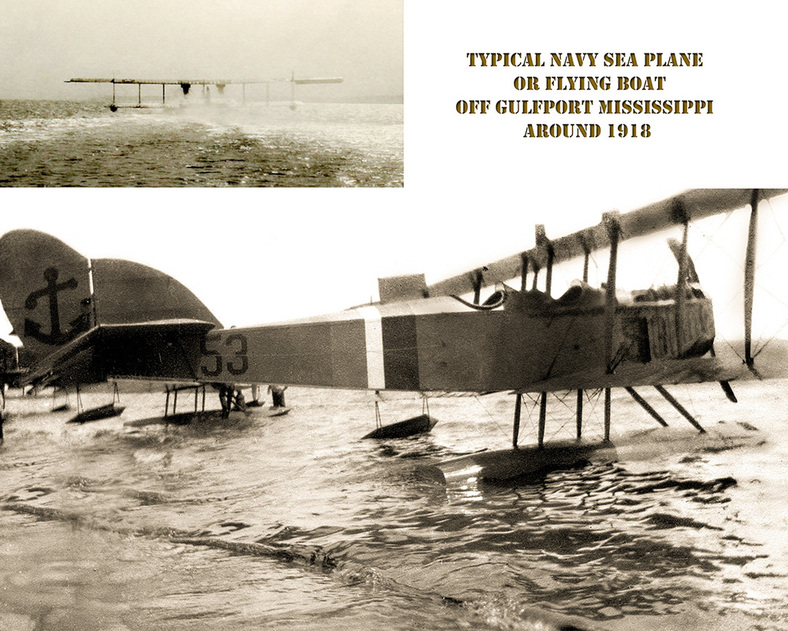 The original Model C-1F had a single main pontoon and small auxiliary floats under each wing and was powered by a Curtiss OX-5 engine.
The original Model C-1F had a single main pontoon and small auxiliary floats under each wing and was powered by a Curtiss OX-5 engine.
On November 23, 1916, Pacific Aero-Products tested its first all-original airplane, the Model C naval trainer. The Model C two-cockpit training seaplane was to become the first "all-Boeing" design and the company's first financial success. A total of 56 C-type trainers were built. In a late design change, the military contracted Boeing Model C Naval Trainer used twin pontoons, a minor adjustment to the design of the vertical tail section, and the anchor was replaced with red, white and blue military stripes seen on the fuselage.
THE CAPTION FOR THE AERIAL PHOTOGRAPH OF THE NAVAL TRAINING CAMP STATES THAT FLYING BOATS TRAINED AT THE BASE. THE AERIAL VIEW WAS ALMOST CERTAINLY TAKEN FROM A NAVY SEAPLANE BASED IN PENSACOLA. PRIOR TO THE ESTABLISHMENT OF THE GULFPORT CAMP, SEAPLANES FROM PENSACOLA MADE FLIGHTS TO AND FROM THE NAVAL STATION IN NEW ORLEANS, AND ON RARE OCCASIONS LANDED IN THE MISSISSIPPI SOUND AT GULFPORT. I HAVE FOUND NO EVIDENCE THAT SEAPLANES WERE BASED AT THE GULFPORT NAVAL TRAINING CAMP. HOWEVER, GIVEN ITS PROXIMITY TO PENSACOLA, AVIATION MACHINISTS AND AVIATION ARTIFICERS’ COURSES WERE INCLUDED IN THE CURRICULUM AT GULFPORT.
BUTCH MARTIN, 2015
THE CAPTION FOR THE AERIAL PHOTOGRAPH OF THE NAVAL TRAINING CAMP STATES THAT FLYING BOATS TRAINED AT THE BASE. THE AERIAL VIEW WAS ALMOST CERTAINLY TAKEN FROM A NAVY SEAPLANE BASED IN PENSACOLA. PRIOR TO THE ESTABLISHMENT OF THE GULFPORT CAMP, SEAPLANES FROM PENSACOLA MADE FLIGHTS TO AND FROM THE NAVAL STATION IN NEW ORLEANS, AND ON RARE OCCASIONS LANDED IN THE MISSISSIPPI SOUND AT GULFPORT. I HAVE FOUND NO EVIDENCE THAT SEAPLANES WERE BASED AT THE GULFPORT NAVAL TRAINING CAMP. HOWEVER, GIVEN ITS PROXIMITY TO PENSACOLA, AVIATION MACHINISTS AND AVIATION ARTIFICERS’ COURSES WERE INCLUDED IN THE CURRICULUM AT GULFPORT.
BUTCH MARTIN, 2015
OFFICERS AND ENLISTED PERSONNEL U. S. NAVAL TRAINING CAMP, GULFPORT, MISS. 1918
The Mississippi Centennial: Return to the City of Gulfport
The first land give-back (believed to have occurred prior to 1964) included areas north of 29th Street to Pass Rd. now occupied by Pass Rd. Elementary, Harrison County Youth Court, Herbert Wilson Recreation Center and the Harrison County Child Development Center.

Following the massive damage sustained during Hurricane Katrina in 2005, the facility was closed and services transferred to the Gulf Coast Veterans Health Care System in Biloxi. Many of the remaining original structures were demolished during the site clean-up after the storm. However, the core administrative and health care facilities buildings, including the nurse’s quarters and the chapel, withstood the devastation. A study was undertaken by historians of the National Register of Historic Places in 2007. Their report concluded that the property was still eligible for their designation as a national Historic site worthy of preservation.
Nearly 90 years later, the federal government returned the property to the City of Gulfport, charging it with the responsibility of determining the best and highest use of it for their citizenry and the Gulf Coast.
The City of Gulfport's Redevelopment Commission (GRC) has assigned a long-term lease to Centennial Plaza LLC to develop Centennial Plaza. Stewart Juneau's company, le Triomphe, developer of the historic Maison Blanche building on Canal Street in New Orleans, has been given the lead role in the Centennial Plaza project.
Up Date:
Centennial Plaza reconstruction set.
The GRC's Centennial Plaza’s design team is hashing out the plans. Financing should be wrapped up for construction to begin in December. Centennial Plaza development hinged on the availability of historic tax credits from the state, which had run out. The Legislature replenished the credits earlier this year, allowing project financing to move forward.
Source: Sunherald, 8/30/2016
Nearly 90 years later, the federal government returned the property to the City of Gulfport, charging it with the responsibility of determining the best and highest use of it for their citizenry and the Gulf Coast.
The City of Gulfport's Redevelopment Commission (GRC) has assigned a long-term lease to Centennial Plaza LLC to develop Centennial Plaza. Stewart Juneau's company, le Triomphe, developer of the historic Maison Blanche building on Canal Street in New Orleans, has been given the lead role in the Centennial Plaza project.
Up Date:
Centennial Plaza reconstruction set.
The GRC's Centennial Plaza’s design team is hashing out the plans. Financing should be wrapped up for construction to begin in December. Centennial Plaza development hinged on the availability of historic tax credits from the state, which had run out. The Legislature replenished the credits earlier this year, allowing project financing to move forward.
Source: Sunherald, 8/30/2016

For the latest update on the development of Centennial Plaza,
click here.
Information is from Gulfport, Beginnings and Growth, Henry W. Black,
Charles Sullivan, Professor Emeritus
Archivist, Mississippi Gulf Coast Community College
Charles Sullivan, Professor Emeritus
Archivist, Mississippi Gulf Coast Community College




